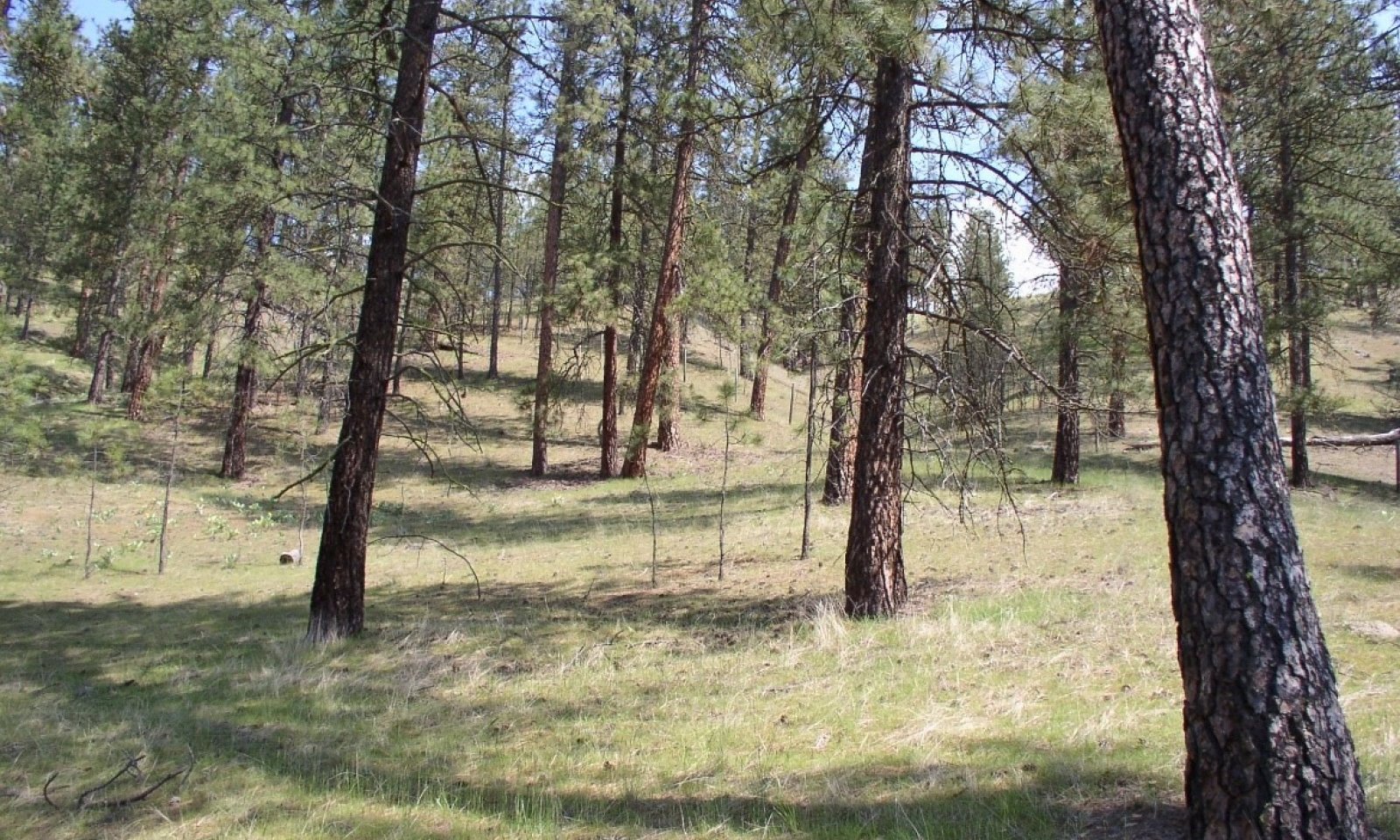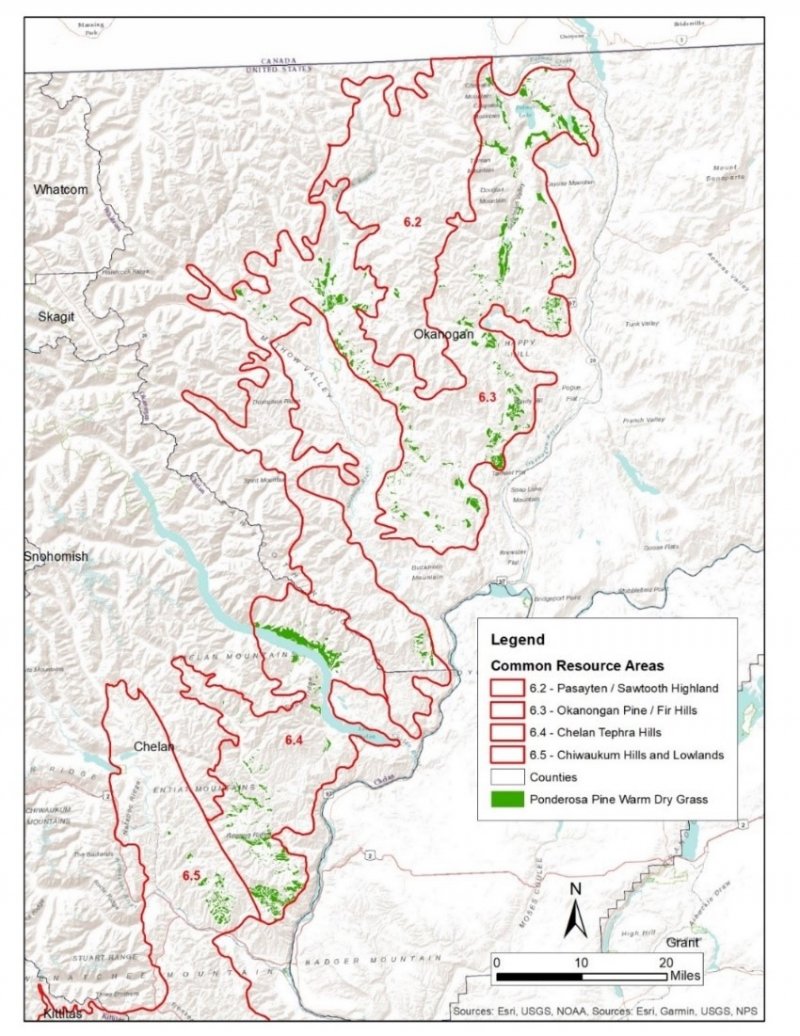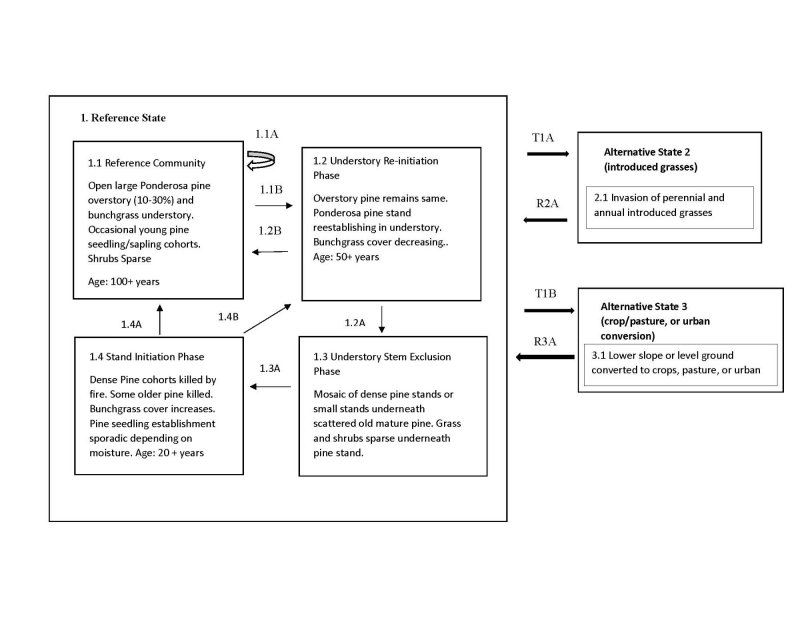Ecological dynamics
This reference site is located on very warm dry slopes with Ponderosa pine the only tree species with an understory of mainly bluebunch wheatgrass, Idaho Fescue, and some needle and thread grass. Average elevation range is 1800 – 3800 feet. Average precipitation range is 15 - 40 inches. Tree stocking is low with large open grown Ponderosa pine and small amounts of sapling/pole size pine in understory. Frequent ground fires every 10-15 years kept pine regeneration low and perpetuated this condition with a dominant grass understory. With fire exclusion a mosaic of pine cohorts underneath the large pine survive, but rarely form a closed canopy. In addition, some woodland shrubs may establish, and an occasional Douglas-fir is restricted to microsites. Soils are mainly sandy loams or loamy sands. The main/modal plant association in this ecological site is Ponderosa pine/bluebunch wheatgrass. Other plant associations this ecological site includes are PSME/PSSP, PIPO-PSME/AGIN, PSME/SYAL/PSSP, and PSME/CARU-PSSP. Douglas-fir will be more prominent at higher elevations and woodland shrubs can be present in the understory. On most sites Douglas-fir will be subdominant to pine.
State 1
Reference
This state is dependent on the occurrence of frequent low intensity ground fires keeping an open grown pine stand with a dominant ground cover of bunchgrass. When fire intervals are infrequent pine regeneration can survive and a patchy pine woodland develops underneath the large old pine. With drought stress the large old pine can be subject to beetle kill and the understory pine stands subject to dwarf mistletoe infestation. It is also possible to have a stand replacement fire when stand density is increased and ladder fuels can reach the larger pine crowns.
Major insects that cause mortality in ponderosa pine are the western pine beetle, mountain pine beetle, and pine engraver beetle. The western and mountain pine beetles can kill mature to old growth pine. The pine engraver beetles attack and kill young pole size stands. Drought and tree to tree competition cause stress which increases bark beetle mortality. Other insect concerns in pine include the following defoliators: Pandora moth, pine butterfly, sawflies, and needle miners.
Major diseases include Annosum and Armillaria root rot, commandra rust, and elytroderma needle disease, Dwarf mistletoe is a major concern infecting over 25% of ponderosa pine acreage. It is more serious in the drier ponderosa pine sites. It also can spread more readily in dense stands lacking frequent fire cycles. Douglas-fir mistletoe can also be a concern when Douglas-fir occurs.
Forest productivity is measured using site index (SI) and culmination of annual increment (CMAI). Ponderosa pine is the key tree species and site indexes ranges greatly depending on local site characteristics. NRCS forest site index plots taken throughout MLRA B6 shows this variability. Site index ranges from 60 – 84 using Meyers 100-year total age table. CMAI range is 14 – 46. Low CMAI values depict low tree stocking (density) due to droughty sites.
Forage production estimates from NRCS Range 5 Plots in Okanogan County in Ponderosa pine /bluebunch wheatgrass and PP/Idaho fescue sites are as follows based on overstory tree canopy. Forage production figures are in pounds/acre for all vegetation below 4.5 feet (grass, sedges, forbs, shrubs, tree regeneration): In addition, these Ppine/grass sites are adjacent to 12 – 15 inch loamy-sandy loam range sites composed of bluebunch wheatgrass and fescue in association with sagebrush and/or bitterbrush. Comparisons are made below in forage production.
Overstory tree canopy – Forage production
0 – 20% - 600 to 1100 lbs/ac
60+% < 400 lbs/ac
No tree canopy – 12 -15 inch range site
800 to 1200 lbs/ac
The bulk of the grass production was bluebunch wheatgrass and Idaho fescue. Other grass species included needle and thread grass, prairie junegrass, rough fescue, pine grass and sandberg bluegrass. The most prominent forbs were lupine, basalmroot, pussytoes, hawkweed, and yarrow. The most prominent shrub was bitterbrush. Other shrubs included currant, snowbrush ceanothus, big sagebrush, rabbitbrush, and buckwheat. Tree regeneration included mostly ponderosa pine with an occasional Douglas-fir.
Dominant plant species
-
ponderosa pine (Pinus ponderosa), tree
-
antelope bitterbrush (Purshia tridentata), shrub
-
currant (Ribes), shrub
-
snowbrush ceanothus (Ceanothus velutinus), shrub
-
big sagebrush (Artemisia tridentata), shrub
-
rabbitbrush (Chrysothamnus), shrub
-
buckwheat (Eriogonum), shrub
-
bluebunch wheatgrass (Pseudoroegneria spicata), other herbaceous
-
Idaho fescue (Festuca idahoensis), other herbaceous
-
needle and thread (Hesperostipa comata), other herbaceous
-
pinegrass (Calamagrostis rubescens), other herbaceous
-
prairie Junegrass (Koeleria macrantha), other herbaceous
-
Sandberg bluegrass (Poa secunda), other herbaceous
-
lupine (Lupinus), other herbaceous
-
arrowleaf balsamroot (Balsamorhiza sagittata), other herbaceous
-
common yarrow (Achillea millefolium), other herbaceous
-
white hawkweed (Hieracium albiflorum), other herbaceous
-
pussytoes (Antennaria), other herbaceous
Community 1.1
Reference Plant Community

Figure 2. Ponderosa pine/bluebunch wheatgrass site on south slope. Open grown pine stand.
Large open grown pine with bunchgrass understory. Pine canopy coverage may range from 10 – 30%. Understory dominated by bluebunch wheat grass on the drier sites. Other key understory species include arrowleaf basalmroot, western yarrow, buckwheat, and needle and thread grass.
Resilience management. 1.1A – Historic fire regime. Frequent ground fires burn out regeneration and maintain open pine/bunchgrass.
Community 1.2
Stand Re-initiation Phase
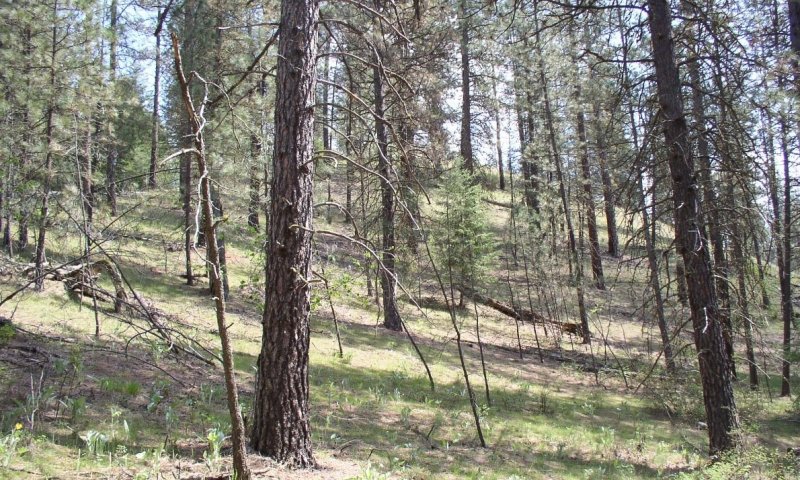
Figure 3. Understory pine become established. Occasional Douglas-fir and shrubs may be present.
Large overstory Ponderosa pines remain at a 10%-30% cover. A prolonged fire interval allows understory pine start to establish. Bunchgrass cover reduced. Woodland shrubs and fir may establish at higher elevations.
Community 1.3
Understory Stem Exclusion Phase
As understory pines cohorts grow, they become ladder fuel to the crowns of the large overstory. Understory pine stands start to decline through competition. Snags and woody debris develop. Beetle kill possible. Stand susceptible to stand replacing fire with possible large old pine killed. Mixed severity fire will thin out understory pine stand, woodland shrubs and kill fir regeneration. Bunchgrass cover will increase.
Community 1.4
Stand Initiation Phase
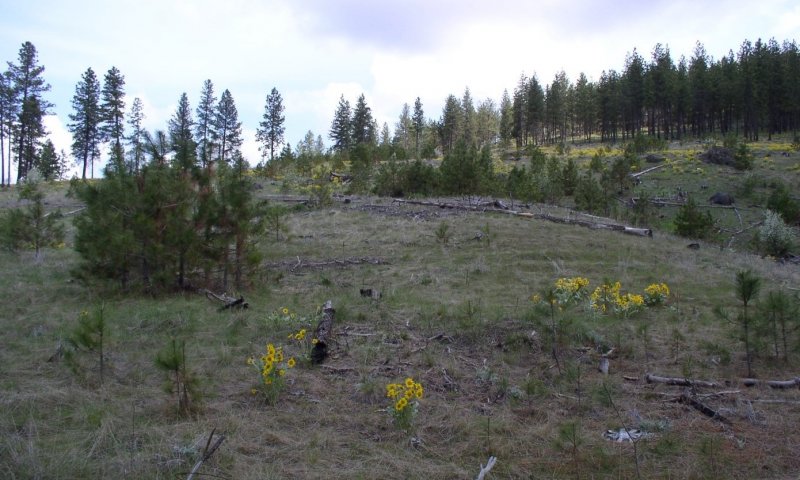
Figure 4. Ponderosa pine / Idaho fescue site with stand replacing fire. Pine seedlings established in clumps after 10 years.
Understory pine stand killed by fire, some larger overstory pine killed. Overstory crown cover may be reduced to 10% or less. Bunchgrass cover increased. Sporadic pine regeneration dependent on moisture, topographic, and good seed crop years.
Pathway 1.1B
Community 1.1 to 1.2
Reference Plant Community
Stand Re-initiation Phase
Time, prolong fire return interval allows pine regeneration to establish.
Pathway 1.2B
Community 1.2 to 1.1
Stand Re-initiation Phase
Reference Plant Community
Ground fires reoccur before regeneration becomes ladder fuel to overstory crowns, returning site to open pine/grass site.
Pathway 1.2A
Community 1.2 to 1.3
Time, a continued lack of fire allowing pine cohorts to form dense patchy, clumps of large saplings and pole sized trees.
Pathway 1.3A
Community 1.3 to 1.4
Stand replacing fire, dense understory pine stands killed, some large overstory pine survive.
Pathway 1.4A
Community 1.4 to 1.1
Reference Plant Community
Historic fire interval resumes, maintaining open pine stand with abundant bunchgrass.
Pathway 1.4B
Community 1.4 to 1.2
Stand Re-initiation Phase
Prolonged fire interval causing increase in pine establishment.
Community 2.1
Introduced Grasses
Invasion of introduced perennial and annual cool season grasses from adjacent pastures, homesteads, and abandoned areas. One particular annual grass of concern from past overgrazing is the invasion of cheat grass. Once it gets established in the understory it will prevent native bunchgrasses from reestablishing and restoring site.
Community 3.1
Conversion to Crops, Pasture, Urban
Lower level terrain converted to crops, pasture or urban development. Much of the ponderosa pine ESDs are adjacent to local towns and cities. They have been converted to housing developments, shopping malls, or urban recreation areas. In the more rural areas, these sites have been converted to pastures and dry or irrigated cropland.
Transition T1A
State 1 to 2
Invasion of introduced perennial and annual grasses outcompete native bunchgrasses.
Transition T1B
State 1 to 3
Land converted to crop, pasture, or urban development.
Restoration pathway R2A
State 2 to 1
Site preparation, native grass reseeding, weed control, grazing protection followed by prescribed burning after establishment to maintain site in reference plant community.
Restoration pathway R3A
State 3 to 1
Afforestation. Site preparation, tree planting, maintenance. Possible planting of native shrubs and grasses. Highly unlikely in urban developed lands unless for parks or conservation lands. Agricultural lands more likely converted if land is retired from crop/pasture or sold to owners desiring trees.
